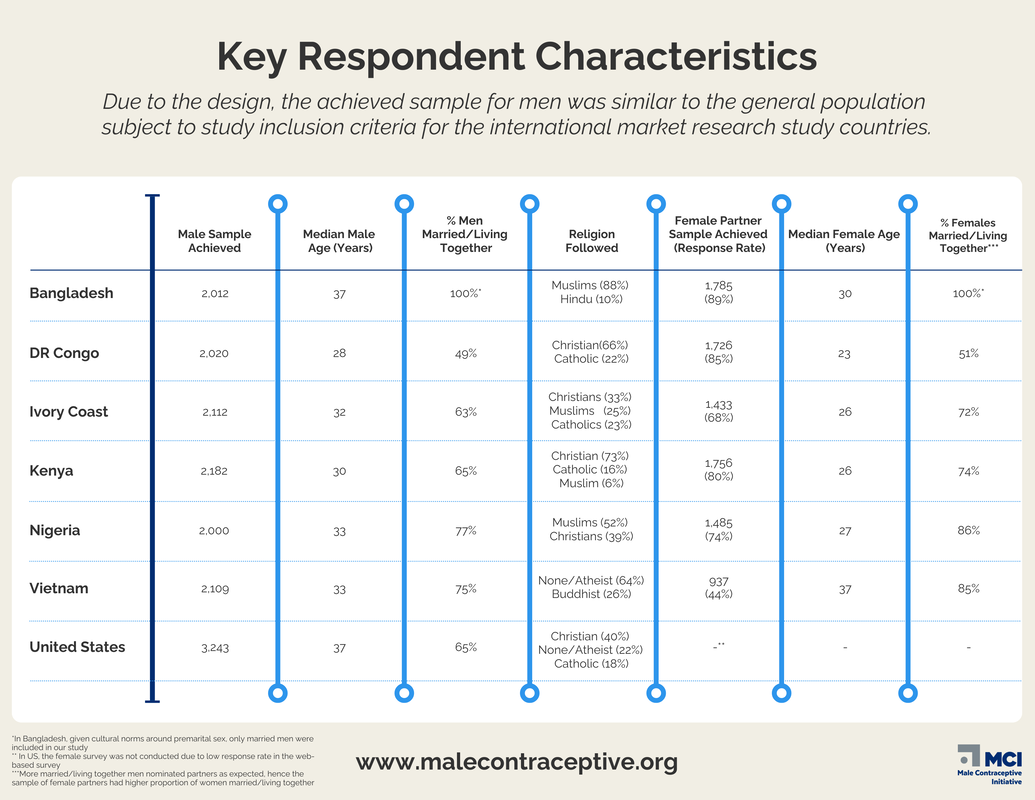Are men interested in birth control methods for themselves? Will their female partners trust men to use contraception?
|
Vertical Divider
|
Men's interest in male birth control and whether or not female partners would trust men to use birth control are arguably the most prominent and persistent questions impacting the field of male contraception research and development, and they are the impetus for this market research study.
|
Study Context
The focal point of this study was to answer this question: Does sufficient latent demand exist in key markets for Male CTs?
Should we consider exploring male CTs? What might be their potential impact? There is not enough data around latent demand for male CTs available and, consequently, there is a need for robust baseline data that facilitates making preliminary go/no go decisions on further exploration of male CT targets and products.
- Currently, there are only 2 male-controlled contraceptive technology (CT) methods (condoms and vasectomy) versus 18 for women.
- There have been observed significant pockets of use of male method use but data is sparse for reasons or context for use.
- Experts hypothesized that new male methods in the portfolio could:
- Have a high impact on reducing the number unintended pregnancies worldwide
- Improve gender equity of contraceptive usage in low- and middle-income countries (LMICs) and developed countries alike
- Have a high impact on reducing the number unintended pregnancies worldwide
- Nearly all research funding focused on developing female CT pipeline
- There is a considerable pipeline of male methods under development despite low funding
Should we consider exploring male CTs? What might be their potential impact? There is not enough data around latent demand for male CTs available and, consequently, there is a need for robust baseline data that facilitates making preliminary go/no go decisions on further exploration of male CT targets and products.
Study Objectives
The purpose of this study was to assess latent demand for potential male Contraceptive Technology (CT) attributes / products on the 5-to 30-year development horizon to inform funding and development decisions among funders and development community stakeholders.
The research objectives were to:
The research objectives were to:
- Assess the overall interest in and attitudes about Male CT among men across geographies that account for more than 50% of unmet need for family planning (FP) in FP2030 countries
- Identify male CT product attribute preferences, and attribute clusters (TPPs) most preferred
- Cluster-segment men according to their Male CT attribute preferences and who they are; size and profile segments
- Assess trade-offs made by female partners in their FP method use if men use Male CTs; input into overall mCPR impact modeling
- Provide male user-based demand data as inputs into demand forecast and impact modeling
Key Questions
Understanding participant responses to the following questions about demand for Male Contraceptive Technologies was critical to the study:
- Do men want additional Male CT options?
- Assess overall demand for and attitudes about Male CT among men across geographies accounting for 50+% of FP unmet need in FP2030 countries
- What additional Male CT options do men want?
- Identify male CT product attribute preferences, and attribute clusters (TPPs) most preferred
- What would be the impact of a new male method on mCPR?
- Estimate incremental contribution of new male methods to mCP use
- Would women trust men to use Male CTs to protect them from pregnancy? What will women do – continue using or rely on their partner?
- Assess trade-offs made by female partners in their FP method use if men use Male CTs; input into overall mCPR impact modeling
- Who wants which Male CT options?
- Cluster-segment men according to their Male CT attribute preferences and who they are; size and profile segments
Respondent Characteristics
Participants were men, ages 18-60 who had engaged in sexual activity with one or more women within the past year, and those who are able to father children based on self reporting. Participants currently approach contraception in a wide variety of ways: from using modern methods to nothing at all.
Key Respondent Characteristics
Respondent Characteristics: Current Contraceptive Method Mix
Contact
For more information regarding this study, please reach out to us at [email protected] or fill out this contact form:










